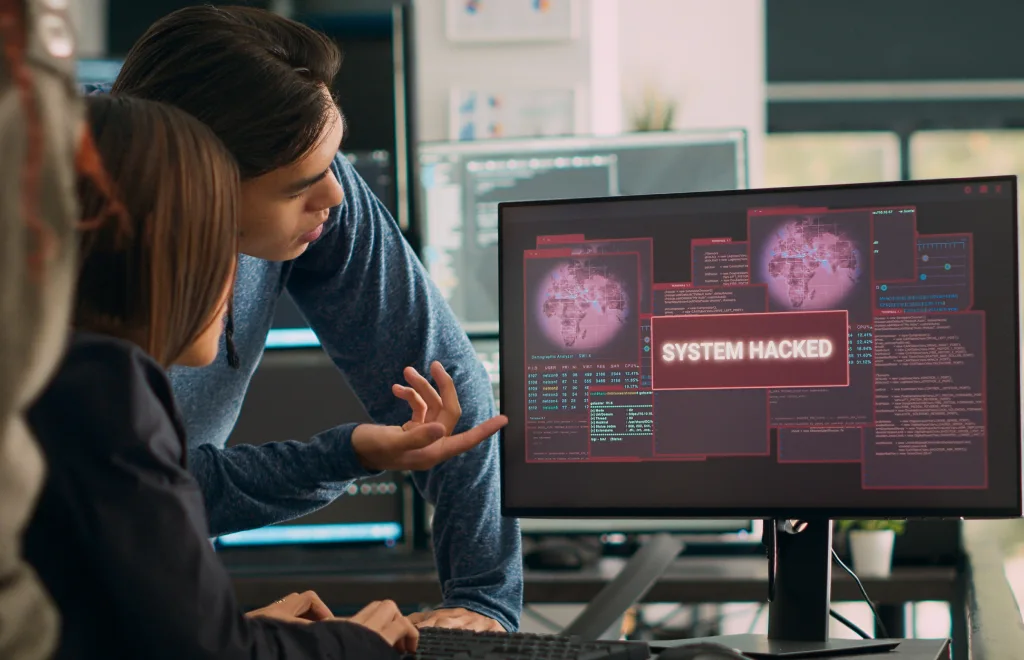Project Risk Management in 2024: The Ultimate Guide
Project risk management is one of the many tasks a project manager has. It’s a part of the project itself, and it doesn’t come without some challenges.
We’ll explore what project risk management entails and its impact on the job of a project manager and their team.
These situations can be stressful for everyone involved, so it’s also important to learn from every experience and know how to mitigate risks and avoid problems in the future.

Free eBook: The Project Manager’s Handbook on Time Tracking
Get your step-by-step guide to master time tracking as a Project Manager
What is project risk management?
To correctly define project risk management, we’ll have to start with the two first words: project risk.
According to the Project Management Institute (PMI), project risk is defined as the possibility of certain occurrences adversely affecting the project’s objectives, the degree of exposure to negative events, and their likely consequences.
The project risk can be defined across three factors: risk identification, risk probability, and what the risk puts at stake. In three questions: what can happen, how likely is this going to happen, and what can be lost as a consequence?
They’re part of the project process, and identifying, analyzing dealing/responding to these factors is what defines project risk management.
The impact of the risks in each stage of the project life cycle needs to be handled with a carefully crafted plan. And, this is one of the main responsibilities of a project manager: risk management.

What are the types of risk?
The different types of risks are internal, external, technical, and PM risks. There are other risks, but these are the most common types of risk a project can endure.
The risks will usually depend on the current environment and circumstances that surround it and its team. The PMI explains that depending on the industry and specific methodologies used, there can be defined different types of risk.
We’ll consider an elementary list of types of risk that the institute uses:
Internal risks
These are risks that can exist inside the organization’s control. They exist at the level of an organization, department, team, or project.
Some examples are schedule risks, health risks (inside the organization/team), and cost risks, among others.
Get to know how time estimation can help you reduce internal risks in project management.
External risks
These are issues that exist outside the organization’s control and especially beyond the control of the team working on a project.
Governmental changes, environmental changes, and major economic problems are some examples. The Covid-19 pandemic, a global health problem, was one of these external risks, that no project is entirely isolated or safe from.
The pandemic affected supply chains, the exchange of goods among countries, and even the workforce.

Technical risks
Technical risks are those connected to technology. For example, problems with software, hardware, digital network, digital assets, cyber security, new technology, and changing regulatory requirements.
Imagine, for example, problems in connectivity, malfunctions with a computer, compliance with norms and regulations, etc.
PM risks
This group includes the efforts to manage the project and the obstacles found along the way. It includes project management work and tasks within communication, estimating, planning, contract development, and scoping.
A tiger team might be the solution you need to fix something in your project.
Note
It’s important to note that sometimes a cost risk, a software risk, or an operational risk can be of internal or external types, depending on the circumstances and conditions surrounding it.
Every problem needs to be thoroughly analyzed for its risks to be correctly identified.
TIP: Learn how to track and manage risks in our guide about Project Tracking.

Free eBook: The Project Manager’s Handbook on Time Tracking
Get your step-by-step guide to master time tracking as a Project Manager
Examples of risks in project management
The potential for risks is always present, so having a defensive view of your work scenario is advisable. By doing this, solving these problems gets easier. Check out some of the most common ones.
- High costs – sometimes things go over budget, and this can happen because of unrealistic budgeting in the project planning phase. Going over the budget might still be a problem regardless of a perfect plan, but it’s still best to detail everything cost-wise from the beginning.
- Underwhelming performance – this happens when a project doesn’t perform as initially planned. The cause for this is hard to pinpoint and identify, but it’s possible to identify these risks (that include miscommunication among colleagues) and try to prevent them.
- Scheduling issues – risks that involve time are common, as a project can take longer than expected initially. On top of it, delayed timelines might impact other things like budget, delivery date, or performance.
- Lack of resources – in the resources group, we may include time, money, tools, and people. The project manager is responsible for securing resources and keeping communication channels open in order to be informed about the status of these resources. Things might happen unexpectedly, resulting in the stretching of lacking resources.
- Operational issues – this example of risk management includes changes in management or in team roles, or the implementation of new processes, just to name a few. These situations can create delays and distractions.
Find out why a project management communication plan is important to reduce risks in project management.

How to manage project risks in 6 steps
The best way to manage the risks of a project is to build a risk management plan and follow that process. This method needs to be embraced by everyone involved in the project.
Here are the steps that need to be followed to find a risk management solution.
1. Identify the type of risk and its circumstances
To solve a problem, you need to identify it. After identifying the type of risk, collect the biggest amount of data possible on it and its surroundings.
Involve your team and colleagues in discussing the risks and ways of resolving them. It’s also useful to look at past projects that can inform what can go wrong/is going wrong with the current one.

2. Analyze the risk
With all the gathered information (the process of collecting it actually never ends), you’ll need to follow up with risk analysis.
A good project management software helps with this analysis, and it’s likely that an organization already has one or a risk management framework defined in its internal processes.
By analyzing all the information gathered about risk in both a qualitative and quantitative way, it’s possible to address its impacts and probably avoid future issues proactively.
3. Make it a priority
Different risks present different degrees of danger. The previous analysis and evaluation will help you organize them by categories: high, medium, or low. By doing this, the plan to address this risk becomes clearer.
There are always risks that need immediate action, going a step above high in the scale of importance, and by acknowledging this and organizing the rest, time will be better used when addressing them.
4. Assign an owner to the risk
Every risk identified should be assigned to someone who’ll be leading the work toward its resolution.
The project manager is responsible for choosing the correct person to handle the problem, considering the person’s skills, experience, and area of expertise.
5. Response to the risk
Time to put the plan into practice. After identifying the risk and analyzing and assessing it, it’s time to deploy the strategy planned to respond to it.
You can go a bit further by trying to take advantage of said risk by trying to figure out if any benefit can come out of it. From there, the manager and the risk owner act according to the risk management plan developed.

6. Monitor the risk
The person in charge of the risk can’t stop monitoring it. The risk needs to be “taken care of” until its resolution.
The owner has to keep the manager in the loop of things through calls or e-mails to have an accurate picture of the project’s overall progress.
What are the challenges in project risk management?
Project risk management doesn’t come without some challenges. Once again, these challenges depend on many factors, including the type of project and the risks it entails, whether they were already identified or not.
Starting with this, one main challenge can be difficulty in correctly identifying the project risks. This can happen due to a lack of collaboration between stakeholders and management in thinking about the possible risks of the project.
Adding to this, the leadership/management disengagement from the project management plan issues is also a challenge.
Another obvious challenge that is still overlooked at times is handling many projects simultaneously and the risks associated with every single one of them. Managing one project already demands attention to every single risk and way to mitigate it. Managing several results in an extra challenge and adds an extra layer of organization that brings more costs, needs more resources, etc.
Another common issue comes up when a risk management plan has been developed, but the process itself is not given due importance, and therefore, it ends up not being implemented.
TIP: Read our blog and learn how to manage multiple projects at once.
How you can mitigate risks
Mitigating risks falls mainly on anticipating them and planning. In responding to the examples of risk previously discussed in this article, it’s clear that every one of them requires planning for the worst-case scenario, anticipating risks, creating alternative plans, and sticking to all of them very closely.
More formally, we can list five mitigation strategies to help mitigate risks.
- Accept – by accepting the risk, its analysis defines the consequences of each risk to see which ones are acceptable. What can be done to solve it, and what team members can help mitigate it?
- Avoid – By avoiding the risk, the team members come up with ways to avoid the possibility of the risk happening. The goal is to create a plan for a hypothetical risk and have a preventive attitude to avoid it.
- Control – If the risk cannot be avoided, it must be controlled. What action(s) needs to be implemented to control the risks’ impact?
- Transfer – This strategy involves attributing the responsibility of the risk and its consequences to a different party, such as insurance.
- Monitor – It’s critical to monitor all the risks to note changes that happen during a project’s lifespan. Team members must take up the responsibility to monitor the project for changes and look out for new risks.
Read our article and find out why having a project management checklist minimizes the risks.
FAQs
What is a project management risk plan?
A project management risk plan outlines how a project’s risk management process will be executed. This document defines how to approach risk management, how to understand best and manage the risks related to the project, and the responsibilities of each team member in managing the risk.
What are the steps of project risk management?
The steps of project risk management are identification, analysis, prioritization, ownership, response, and monitoring.
What are the best risk management tools?
The essential tools to handle risk management can be present in the software you use for project management or on others easily found online: marketing analysis, budget tracking, resource management, brainstorming sessions, having a quality assessment process, registering risks, designing a probability matrix and performing a good root cause analysis.
What is the risk matrix formula?
A risk matrix is used for risk assessment. One of its axis is used to assign the probability of a risk, and the other is used to determine the consequence or severity. So, risk equals probability times severity.
Conclusion
The most essential idea to retain from this overview of project risk management is the need for planning.
The planning phase is the most important of any project, as it’s when you anticipate problems and risks, making everything go as smoothly as possible.
Risk management and mitigation are critical, and their strategies must be implemented in every project stage. For this to be successful, everyone involved, from the manager to the staff and even the administration of the company, needs to have sufficient knowledge and training to implement various risk management practices.
You might be interested in: